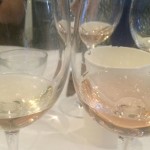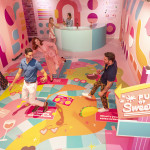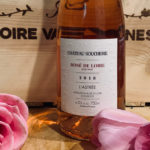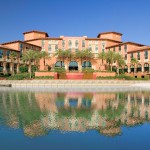
Italy has long been a well-established destination for impeccable cuisine and wine, but there are still many Italian regions that yield delicious wine which are largely unfamiliar to Americans. I once took a solo trip to the popular Italian destinations of Rome and Florence to get a feel of the region’s food and wine. Twelve years later, after writing a feature article pairing different styles of rosé with various cuts of steak, I found myself headed to Italy again. But this time as a guest of the wine council, Consorzio di Tutela Chiaretto e Bardolino, to get to know Bardolino Chiaretto — the rosé of Lake Garda.
Located in the northern part of the country, in the province of Verona (the birthplace of Shakespeare’s fictional lovers Romeo and Juliet), Lake Garda is arguably one of the most beautiful places you will ever visit. Surrounded by the Dolomites, it is Italy’s largest lake, covering 143 square miles. The region was formed at the end of the ice age when enormous glaciers cascaded down from the Alps, forming lakes with mineral-rich rocks and soil. Those unique rocks and soil create a superb terroir for producing wines like Chiaretto. The region is also known for its aromatic lemon trees and olive vines, which thrive even during the chilly winter months.

While the market for rosé is booming here in the U.S., much of the pale pink rosé we’re familiar with comes from France. Despite 8.5 million bottles being produced per year, Americans are largely unfamiliar with the charming wine hailing from Lake Garda. It is mainly sold throughout Italy and Germany, but I think that’s all about to change.

Chiaretto (pronounced key-a-ret-toh) is a dry, pale rosé made primarily from the Corvina and Rondinella varieties. If those grapes sound familiar, it’s because they’re also an important blend used in the widely-known Valpolicella and Amarone wines. Corvina is the indigious grape that dominates the northeast Veneto region in Italy. The thick-skinned, red grape has bold tannis and high acidity, it produces wines that are pleasantly fruit forward.

The name Chiaretto is derived from the Italian term “Chiaro” which means light or pale. While its origins date back to the 1800s, it wasn’t until 1968 that Chiaretto from Bardolino was awarded the coveted Denominazione di Origine Controllata (DOC) status. Lake Garda’s ideal mild, sometimes even Mediterranean, climate and moronic soil create a wonderful terroir, but the wine making process contributes to the characteristics of the pale pink wine, as well. After harvesting the grapes at their peak ripeness, similar to the rosés from Provence, the grapes are then pressed immediately so the grape juice doesn’t retain much color from its skin. The result is a young, dry and pale rosé with light aromas of citrus, berries and even hints of florals. And its signature “salty” mineral notes are pleasantly light on the palate.
Chiaretto embodies the charm of Lake Garda. Just like the region it hails from, Chiaretto’s charm lies in its ease and unpretentiousness. It can be enjoyed year round and pairs beautifully with seafood, fruit, poultry, pastas and yes, even certain cuts of steak.

The Producers of Lake Garda
Whether they’re modernized, state of the art wineries or castles, winemaking in Lake Garda is rooted in family. While the passion of producing great wine has been passed down from previous generations, the new generation brings their own uniqueness to the family business. The combination of family traditions and forward-thinking techniques are clearly one of the reasons why Lake Garda wines are so magical.

Le Morette
Situated in Lugana, Le Morette was founded by Gino Zenatin over 60 years ago. Today his two grandchildren, Fabio and Paolo, are at the helm of the family business. In 2013, Le Morette opened a state-of-the-art winery focusing on sustainability. The Le Morette Chiaretto is well-balanced, with fruit characteristics and a dry finish.

Villa Cordevigo
Owned by the Cristoforetti and Delibori families, the Villa Cordevigo estate not only has its own vineyard, but includes luxury accomodations and the Michelin Star restaurant, Oseleta. The Villa Cordevigo Chiaretto has delicate citrus and floral aromas with a crisp finish and is produced with organically grown varieties.

Villa Calicantus
Just two kilometers away from Lake Garda, tt may be one of the smallest wineries of the Bardolino wine region, but this lovely family-run winery was one of my favorites. What it lacked in size, it made up in old world charm and distinguished wine. The Calicantus philosophy: “Respect of the terroir.” Villa Calicantus has been producing organic wine since 2011. And in 2014, it started making biodynamic wine.

Cantina Gorgo
Located in the town of Custoza, Cantina Gorgo was founded in 1973 by Roberto Bricolo. Currently, Gorgo is managed by Roberto and his daughter Roberta, who formerly practiced law in Bologna before joining her father in winemaking. The winery produces elegant wines such as Pinot Grigio and Chardonnay. Cantina Gorgo has been a certified organic since 2018, a move that was initiated by Roberta. The Gorgo Chiaretto is beautifully colored, dry and crisp.

Cavalchina
Established in the early 1900s, the Cavalchina winery sits on the southeastern border of the Garda amphitheater. While the vineyards were established back then, it wasn’t until 1962 that the Piona family became the first producers to label their white wines made from Fernanda, Trebbiano and Garganega varieties to come with the Custoza name. The winery’s Chiaretto is pale in color and has an apple and pear aroma with a delicate finish.
Le Fraghe
I was a little more familiar with this producer because of its popularity in New York City. Matilde Poggi has been making wine since the early 1980s, and since 2009, Le Fraghe’s vineyards became certified organic. The Le Fraghe Chiaretto has subtle notes of wild strawberries and red currant, as well as a light minerality on the palate.

It’s hard to understate the magic of Lake Garda and Bardolino. If the breathtaking views don’t seduce you, the region’s wine, cuisine and residents definitely will! Thank you to the Consorzio for sponsoring my trip to Lake Garda’s wine region.















